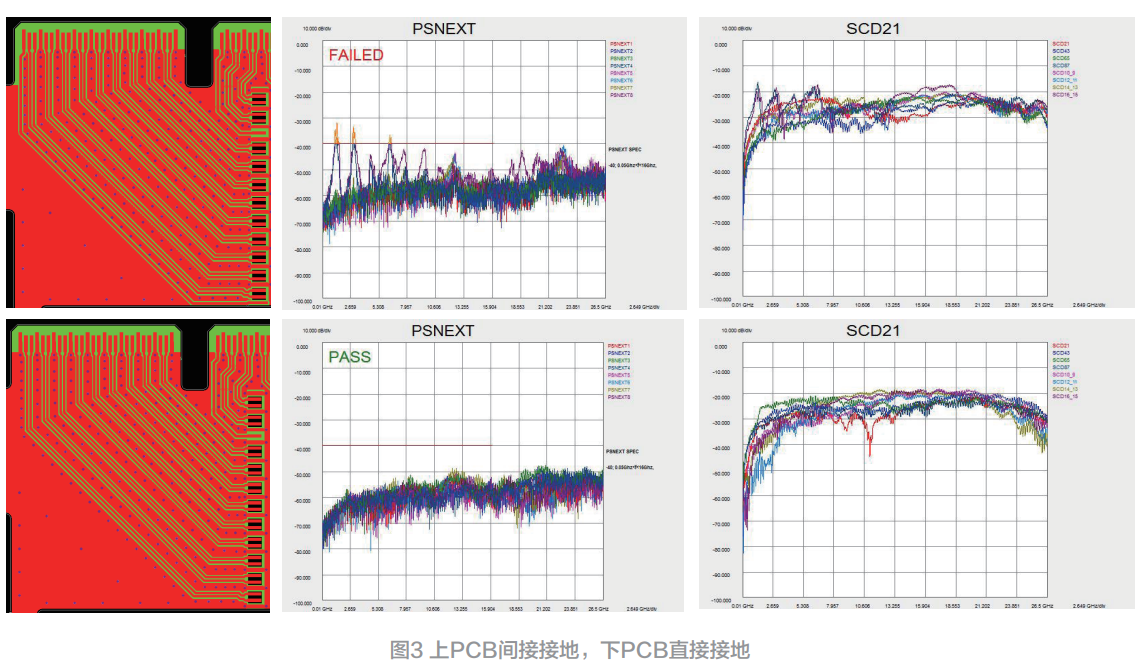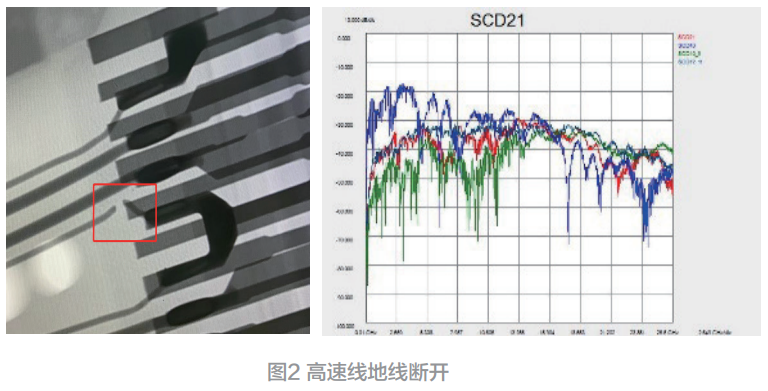1 Return Path (return place)
Circuit signals can be basically divided into two categories, low speed signal and high speed signal. Any signal will have a corresponding return path. Low speed signal corresponds to a low frequency loop, while high speed signal corresponds to a high frequency loop. The low frequency loop of low speed signal can return along the actual connection line, while the high frequency loop of high speed signal is completely different. It will follow the transmission path of high speed signal and form its own return path in the nearby plane or ground wire, without returning to the actual connection line. [1] At this time, in order to ensure the integrity of signal transmission, it is necessary to design a ground plane that coincides with the reflux path, which is referred to as the return ground in this paper, as shown in Figure 1

图1 高频回路与低频回家的返回路径
2. Comparison of one side of PCB a high-speed differential signal with discontinuous and continuous measured results
There was a case in the actual project, that is, the return ground of one pair of difference wires on the leftmost side of the first row of PCB was not directly grounded, but indirectly grounded after welding the cables through the welding pad (as shown in Figure 3), similar to the jumper grounding method (as shown in Figure 3). In contrast, the leftmost pair of difference wires on the bottom of PCB was designed with bilateral symmetry. The two PCBS welded the same high-speed cable and matched the same on-board connector. The results showed that the high-speed cable with asymmetric design was returned with abnormal cross-talk in the near end, and there were several obvious raised interference signals within the frequency of 10 GHz. Compared with the cable with symmetrical design below, no abnormal noise appeared in the whole frequency band. In addition to the large difference of near-end crosstalk, the difference of difference-mode to common-mode signal is also very large. In high-frequency circuits, common-mode signal belongs to interference signal. As a designer, we should try our best to prevent common-mode signal from being too large, especially the difference-mode to common-mode signal. [2-3] From the actual test results, it can be found that the asymmetric design of the return ground is one of the sources of common-mode signal, and the symmetrical design of the return ground is just an effective method to solve the differential mode to common-mode.
In summary, the design of asymmetric return ground will lead to large crosstalk and poor common-mode suppression. In the design of return ground, it is necessary to achieve left-right symmetry as far as possible. Remember that the principle of symmetry should not be abandoned in order to be compatible with low-frequency signals, which will bring great bad effects to high-speed links and may even fail to pass system tests.以上翻译结果来自有道神经网络翻译(YNMT)· 通用场景

3 The return ground cable of the high-speed cable is disconnected
A case is specially found (as shown in Figure 2). In the welding process, the ground wire on one side is broken off. From the perspective of low frequency, although the ground wire is broken, it can be indirectly connected through the hole of PCB, and the aluminum foil of high-speed cable can be used to connect the ground wire. However, from the perspective of high frequency, the difference is great. When the high-speed return signal goes to the place where the broken line cannot pass, it will form a new return path through detour or radiation. In this way, one signal line with the difference pair has a smooth loop, while the other one does not, resulting in prominent asymmetry and common-mode noise. It can also be seen from the measured results that the noise from differential mode to common mode is significantly higher than other normal signals when the return ground is disconnected. This result further supports the importance of symmetry design of return ground. It is absolutely impossible to judge high frequency signal loop from the perspective of low frequency signal loop
。

4 Simulation Verification
In order to verify the theoretical feasibility, two PCB models were specially built for simulation. The ground wire at the very edge of the left PCB was not directly grounded. The second one was grounded through the aluminum foil of the end high-speed cable, while the right one was made of symmetrical design and directly grounded. In order to verify the insertion loss, near end crosstalk and differential mode to common mode at the same time, 8 ports are set up and two sets of differential line pairs corresponding to the top and bottom of the PCB are selected. Other things like the number of simulated grids, PCB materials, conductor characteristics, port types, etc., are all set the same. As shown in Figure 4, (left) indirectly and (right) directly. The width of the simulation frequency is set to 40 GHz. Here, the result of the red dotted line is used to express the indirect simulation result of the left model, and the result of the blue solid line is used to express the direct simulation result of the right model.

图4 仿真模型以及仿真结果

图5 Type-C板端连接器标准接口定义

图6 连接电容模型与仿真结果对比
5 Closing Remarks
By means of case study, this paper compares the return ground asymmetry and return ground symmetry in terms of signal integrity performance. The most obvious difference is that near end crosstalk and differential mode to common mode are noisy. Through simulation, the two models are compared, and the insertion loss, near end crosstalk and differential mode to common mode are observed at the same time. The simulation results are consistent with the measured results. Therefore, in the design of high-speed link, symmetry should be taken as the principle, so that the return should be designed as direct as possible. If actual conditions do not allow, appropriate capacitors can be considered to solve the cross-layer problem and alleviate the asymmetry problem. The conclusion of this paper can provide a design reference for signal integrity engineers and PCB design engineers in the processing of high-speed signal lines. High-speed circuits should not be considered in the way of conventional circuits, but the concept of high-frequency circuits should be used to deal with the possible risks of high-speed links. For example, the return ground wire is disconnected or not directly grounded, which is measured with a multimeter. They are all on-going, but when it comes to high frequency loops, the return path is completely different, creating a series of problems with signal integrity. In short, high speed circuit should pay attention to symmetry, especially the return to the ground processing.
 Shenzhen HongYuan Electronics Co.,Ltd
Shenzhen HongYuan Electronics Co.,Ltd